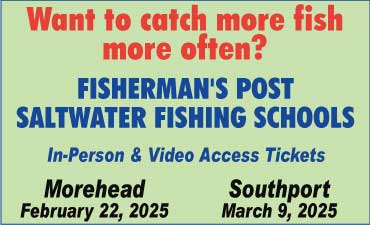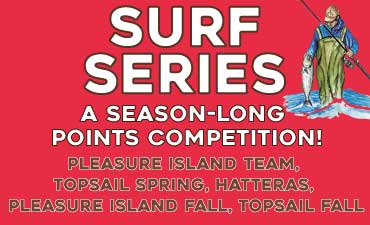Coastal Life Outfitters: The Power of the Surf
The tires were down to 19 lbs., so we had no trouble cruising south down the majority of Fort Fisher’s drivable beach looking for a good spot to start our November surf fishing efforts.
Gary Wall, of Coastal Life Outfitters, was driving, I was riding shotgun, and the day’s surf fishing education had started, as I knew it would, as soon as I met Gary in the parking lot to hop in his GMC. He loves to share his surf fishing knowledge, a large part of the reason he started Coastal Life Outfitters, his business that primarily takes groups of 2-4 people on guided surf fishing trips on Topsail, Wrightsville, and Pleasure Island.
Right before we turned around to head back to a section of the beach that had caught Gary’s eye, he had been talking about the theory of the crossovers, that they were places where sailboats came across the river and then those sailboats were rolled across the barrier island on logs to get to the ocean to fish. However, the surf fishing knowledge he was currently sharing was how to spot a good surf zone for targeting such late season species as sea mullet, bluefish, drum, and trout.
“How the waves look differently indicates the depth of the water,” he began. “After a wave comes across the sandbar as a breaker, it will go back into what looks like a swell over deeper water. I want to target that deeper water and the edges around that deeper water.”
With surf fishing, just like with all fishing, where you choose to fish can be the biggest determinant of success. The ability to read a shoreline is typically one of the first areas that Gary addresses with clients. The goal is not just to get people catching fish from the beach but to teach them how to catch fish, and that starts with finding fish.
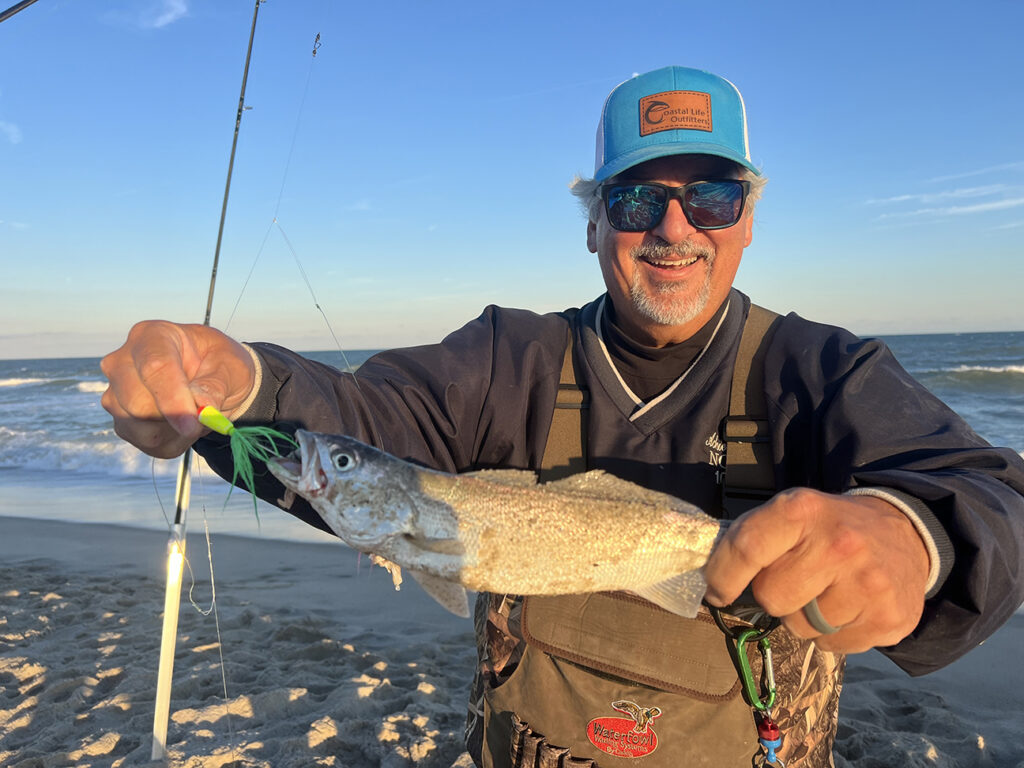
Gary Wall, of Coastal Life Outfitters, with a gray trout caught on a salted piece of cut shrimp. He was fishing a slough about 20′ from the Fort Fisher surfline.
“I also look for places in the sandbar where the waves aren’t breaking. This indicates a break in the bar,” he continued as he pulled his truck to a stop with the nose facing out to the ocean and him pointing at the very conditions he was describing. “When the water’s running out or in, fishing along the edges of those breaks in the bar is really good structure to fish. You target the inside edges of the bar on the incoming tide, and the outside edges of the bar on the outgoing tide.”
We both walked to the front of the truck where Gary started unpacking some of the gear from his Angler’s Fish-N-Mate rod rack. In addition to 10 rod holders, the rack had a bucket attachment on each side—one holding a bucket with bait and the other a bucket with assorted gear. The sand spikes were strapped to the inside of the rack, and these were the first items he pulled.
A couple of the red Striker sand spikes went in easily, and then he grabbed four Deerfield Fabrication spikes and a rubber mallet to finish the layout he liked for our afternoon, spacing the sand spikes at about 10’ apart.
The next task was putting rods in the sand spikes, and Gary talked me through the arsenal of rods he had brought.
“I always have one rod with a metal lure, such as a Stingsilver, to cast for a trout, bluefish, or spanish,” he started. “I like to have 2-3 smaller rods, as in 1-4 oz. and 10’, for sea mullet, spot, croaker, and pompano, and I use mostly Carolina Cast Pro rods, which are good quality rods, so these smaller rods are also suited for red and black drum. Then I pack 2-3 larger, 3-6 oz. rods for bluefish and drum rigs, and 2-3 heavy rods for large drum or a shark.”
The rods he pulled for our five-rod spread already had rigs tied on. They just needed sinkers. The two smaller rods had double-dropper rigs, one dressed up with flashers and the other with floats designed to resemble sand fleas that might be holding eggs. Two other rods had bluefish rigs that were based on Chotty Rigs made by Joe Moore of One More Cast Tackle. Gary’s modification included 90 lb. nylon-coated steel leaders and the hardware crimped. Finally, the heavy rod had a modified fish finder rig with a single 7/0 circle hook.
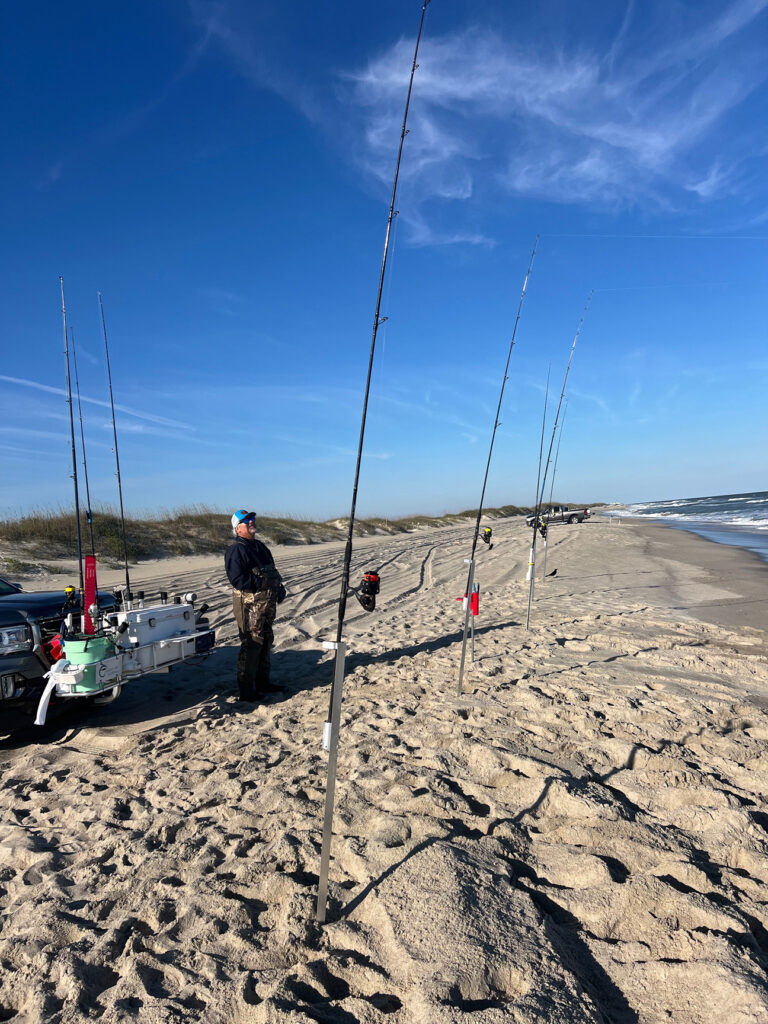
Gary Wall, of Coastal Life Outfitters, stands watch over a five-rod spread covering the main areas of his target zone: an outerbar, a slough, and a shoreline “dip.”
On all five rods, Gary added sputnik sinkers, the ones that look like little four-prong boat anchors. Several companies make sputnik sinkers, but the ones he most prefers come from Chip Brundage of The Sinker Guy out of Florida. They are adjustable, hold strong, and break loose when you need them to break loose.
Next came my education in bait. In the bait bucket on the driver’s side of the front rod rack were two tins, one with cut mullet and one with shrimp, and the two tins were closely nestled in the bucket by three frozen water bottles that kept the tins from moving around. They also saved him money on ice and would last all day, even in the summertime.
“Both the mullet and the shrimp are salted down to toughen the flesh up,” he told me as he pulled a handful of mullet strips and one mullet chunk out of the first tin and then a couple of shrimp out of the second tin, “and salt’s a natural preservative, so it keeps the bait fresher.”
“For the strips, I put the hook in the meat side, out the skin side, and back through the skin side so that the hook is positioned on the meat side with the tip and barb of the hook exposed,” he told me as he demonstrated on one of the double-dropper rigs. “On the shrimp, sometimes I peel and sometimes I don’t. The salt makes the shrimp tough, so I put the hook through the thickest part of the shrimp. On the mullet chunks, I simply put the hook into the meat side and come out through the skin side.”
For setting the spread, Gary was just as strategic and results-driven as he was in all other details. Our seascape was pretty common in surf fishing. We had an outer bar, then a slough, and then the “dip” right at the shoreline breakers. The idea was simple. You want to cast to cover your target area, with some a shorter distance, some an intermediate distance, and at least one to the end of the target area.
Those that have surf fished know that the rod tips are almost always moving, sometimes from fish activity but most of the time from wave activity. A learning curve for almost all of Gary’s clients is reading the rod tip movements.
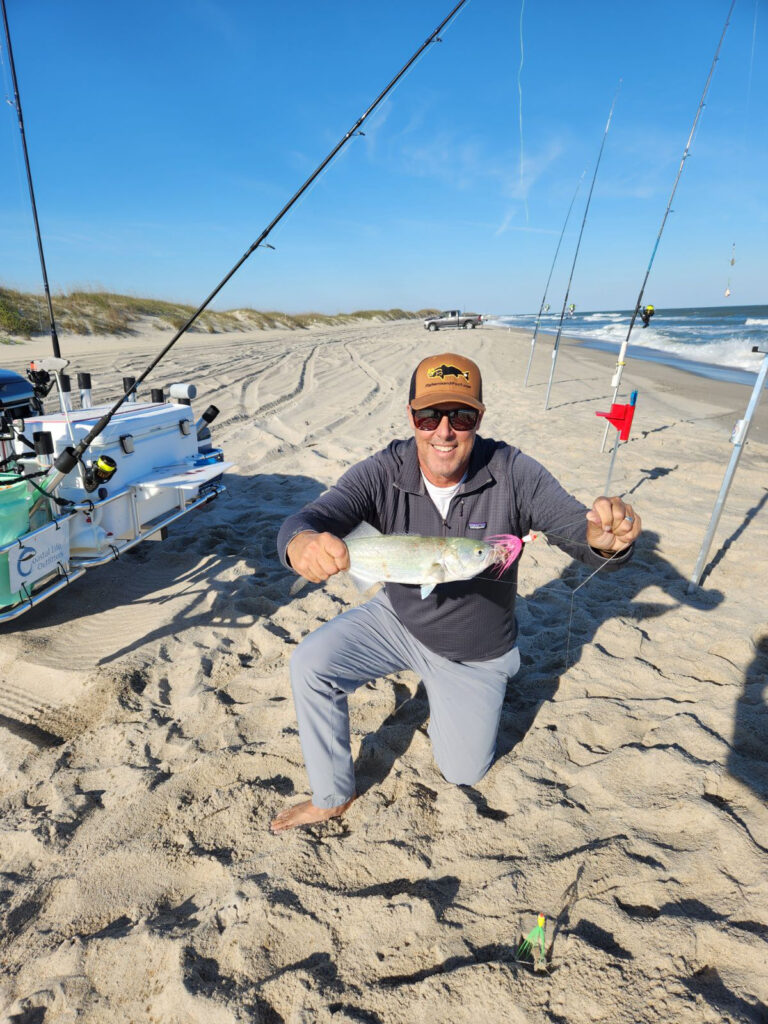
Gary Hurley, of Fisherman’s Post, with one of the bluefish caught using cut mullet on a double-drop rig with floats. He was fishing the Fort Fisher surf with Gary Wall of Coastal Life Outfitters.
Pointing at the two rods closest to us, Gary started, “Lots of time a wave will give the rod a pull, a dip, and then the rod will relax back into its upright position. While a black drum bite can act that way, most of the time it’s a wave. A fish will tend to produce a continuous bouncing of the rod tip, or vibrations that become bounces, or bounces that turn to jerks. People on charters are overly excited at rod activity to start, but then they get a better understanding over the difference during the course of a trip.”
Our conversation on rod tip sensitivity led to me asking him, “Why all mono?” Gary had several reasons.
“For one, mono is easier to untangle than braid,” he began. “Second, most of the reels we are using today have a maximum drag of 12-18 lbs. There are sometimes when you want to put heavier line on a reel, such as for abrasion purposes, but generally there’s no need to put on heavier line than what the drag capacity is on your reel.”
“Also,” he continued, “mono is less expensive. Sometimes when you want to get a line back in the water quickly, you have to ‘untangle’ with scissors. There’s less heartbreak when cutting off 50-foot of mono versus 50-foot of braid.
The bluefish were the first species to cooperate. The sizes were modest, but as it is in the bluefish world, modest bluefish still put up a fun fight. We spent the next hour or so taking turns reeling in and releasing bluefish.
“Reeling in a fish from the surf is different than reeling it in on a boat,” Gary reflected while putting two fresh pieces of mullet on a double-drop rig that just came in with a bluefish. The mullet were being more productive than the shrimp, so Gary was re-baiting with less shrimp.
“You have timing to consider when that fish gets close to shore. You need to literally surf that fish in with the wave. If not, the wave is working against you, and sometimes it will basically suck the fish off the hook.”
When catching bluefish from a boat, the bluefish will often put up a couple of strong runs once it gets close to the boat. The same is true from the surf. When a bluefish gets close to shore, they often start pulling harder and stronger. The idea is to just hold the fish in place during this last minute effort, and then bring the fish in with a wave. When the wave goes back out, the bluefish is stranded on the sand and can easily be picked up.
In addition to as many bluefish as we wanted, we brought in a couple of trout and flounder, and the heavy rod bent over and started steadily peeling line and heading directly offshore, giving the impression of a big shark bite. And when we got cut off, the clean mono cut also seemed to support the shark bite hypothesis.
Other popular species that Gary targets in November include sea mullet and drum, and while the bluefish typically migrate off by Christmas and the trout head for the creeks, the sea mullet and drum will hang in the surf year-round.
While fish can be caught over the winter, mid-April (or when the water gets back above 50 degrees) is when Gary will start booking surf fishing trips with the expectations of bluefish and black drum. The pompano will show not long after.
For summer surf fishing trips, pompano are typically the prize fish, but drum and blues will be in the action, as are croakers, a summertime staple.
Gary Wall has been surf fishing himself since 1966, and 2024 was his first full year of running guided surf fishing trips under the name of Coastal Life Outfitters. You can find out more information about Coastal Life Outfitters by visiting www.Go-CLO.com or by calling (540) 846-4861.
While the practical mission, the one that pays the bills, of Coastal Life Outfitters is taking people out on the beach to catch fish, Gary’s true mission, as he has already had a successful career in government, is to teach people how to surf fish and keep surf fishing alive and growing.
My afternoon with Gary took me back to my childhood days of surf fishing with my father on Assateague Island, and that trip down memory lane that Gary gave me serves both the practical and the true mission perfectly.



